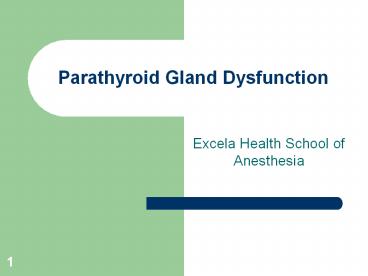Parathyroid Gland Dysfunction - PowerPoint PPT Presentation
Title:
Parathyroid Gland Dysfunction
Description:
... not administer thiazide diuretics for hypercalcemia Primary Hyperparathyroidism Medical Treatment for Life Threatening Hypercalcemia: ... – PowerPoint PPT presentation
Number of Views:351
Avg rating:3.0/5.0
Title: Parathyroid Gland Dysfunction
1
Parathyroid Gland Dysfunction
- Excela Health School of Anesthesia
2
Parathyroids
3
Parathyroid Hormone
- Released into circulation by negative feedback
- PTH release stimulated by hypocalcemia
- PTH maintains normal serum calcium levels
4
Hyperparathyroidism
- PTH level elevated
- Serum calcium levels may be increased, decreased,
or unchanged - Classified as primary, secondary, or ectopic
5
Primary Hyperparathyroidism
- Excessive secretion PTH from benign parathyroid
adenoma, carcinoma of parathyroid, or hyperplasia
of parathyroid glands - Benign adenoma responsible for 90 primary
carcinoma for 5 - Hyperplasia usually involves all 4 parathyroids
6
Primary Hyperparathyroidism
- Diagnosis
- serum calcium gt5.5 mEq/L ionized calcium
- concentration gt2.5 mEq/L
- Measurement of serum parathyroid hormone
concentration is not always sufficiently reliable
to confirm the diagnosis of primary
hyperparathyroidism
7
Primary Hyperparathyroidism
- Signs Symptoms
- early sedation, vomiting
- others skeletal muscle weakness, hypotonia
that may mimic myasthenia gravis - persistent increases in plasma calcium
concentration can interfere with urine
concentrating ability with resulting polyuria - Oliguric renal failure in advanced cases of
hypercalcemia (see handout)
8
Primary Hyperparathyroidism
- Treatment Initially by medical means followed by
surgical removal of diseased area(s) - Medical Saline infusion (150ml/hour) for pts.
with symptomatic hypercalcemia - Loop diuretics (furosemide 40-80mg IV q 2-4
hours - Do not administer thiazide diuretics for
hypercalcemia
9
Primary Hyperparathyroidism
- Medical Treatment for Life Threatening
Hypercalcemia Use of Bisphosphonates such as
disodium etidronate - binds to hydroxyapetite and acts as potent
inhibitor of osteoclastic bone reabsorption - Hemodialysis can also be considered
10
Primary Hyperparathyroidism
- Surgical Management Normalization of serum
calcium levels within 3-4 days - postoperative potential complication is
hypocalcemic tetany - a hypomagnesemia may occur postop that will
aggravate the hypocalcemia and may render it
refractory to treatment
11
Primary Hyperparathyroidism
- Anesthetic Management No specific drugs or
techniques - Maintain hydration and urinary output
- If somnolent preop anesthestic requirements
decreased - If coexisting renal dysfunction use of
sevoflurane is questionable - Careful use of muscle relaxants and
monitoring - Careful positioning
12
Secondary Hyperparathyroidism
- A disease process produces hypocalcemia and
parathyroids compensate by secreting more
parathyroid hormone (ex. Chronic renal disease) - Since secondary hyperparathyroidism is adaptive,
rather than autonomous, it seldom produces
hypercalcemia - Treatment Treat underlying disease
13
Ectopic Hyperparathyroidism
- Due to secretion of parathyroid hormone by
tissues other than the parathyroid glands - (ex. Humoral hpercalcemia of malignancy,
cancer of lung, breast, pancreas, kidney) - Likely to be associated with anemia
14
Hypoparathyroidism
- PTH absent or deficient, or peripheral tissues
are resistant to the effects of PTH - Absence or deficiency of PTH almost always
iatrogenic (inadvertent removal) - Diagnosis Measurement of serum calcium
concentrations and the ionized fractions of
calcium is best indicator - Signs Symptoms Depend of the rapidity of the
onset of hypocalcemia
15
Acute Hypocalcemia
- Can occur after accidental removal
- Likely to manifest as perioral paresthesias,
restlessness, neuromuscular irritability, as
evidenced by a positive Chvosteks sign or
Trousseaus sign - Treatment Infusion of calcium (10 ml of 10
calcium gluconate IV) until signs of
neuromuscular irritability disapper
16
Chronic Hypocalcemia
- Associated with complaints of fatigue and
skeletal muscle cramps - Prolonged QT
- Neurological lethargy, cerebration deficits,
personality changes - CRF is most common cause of chronic hypocalcemia
17
Anesthesia Management
- Management of anesthesia in presence of
hypocalcemia is designed to treat any further
decreases in serum calcium and to treat adverse
effects of hypocalcemia on the heart so avoid
iatrogenic hyperventilation - rapid infusions of blood (500 ml q 5-10 min) as
during CPB or liver transplantation can decrease
ionized calcium concentration - when metabolism or elimination of citrate is
impaired as with hypothermia, cirrhosis, renal
dysfunction































